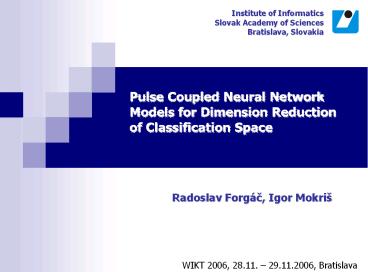Radoslav Forg - PowerPoint PPT Presentation
Title:
Radoslav Forg
Description:
Radoslav Forg c, Igor Mokri . Pulse Coupled Neural Network Models for Dimension ... Structure of PCNN neuron. Mathematical model of PCNN neuron. Feature ... – PowerPoint PPT presentation
Number of Views:79
Avg rating:3.0/5.0
Title: Radoslav Forg
1
Institute of Informatics Slovak Academy of
Sciences Bratislava, Slovakia
Pulse Coupled Neural Network Models for Dimension
Reduction of Classification Space
- Radoslav Forgác, Igor Mokriš
WIKT 2006, 28.11. 29.11.2006, Bratislava
2
Outline
- Goal of our research
- Why we use Pulse Coupled Neural Network (PCNN)?
- Introduction to PCNN
- Structure of PCNN neuron
- Mathematical model of PCNN neuron
- Feature generation by PCNN
- Purposes of PCNN modification
- Overview of PCNN modifications
- OM-PCNN versus ICM neuron
3
Goal of our research
Dimension space of input image D
Input image
D
Dimension reduction of classification
space Minimization of the number of iteration
steps by O-PCNN
n n ltlt D
Dimension reduction of feature space d ltlt D
d d lt n
Dimension of classification space d
d
4
Why we use PCNN?
PCNN Properties
- Invariant to geometrical transformations
- Fixed structure of neural network
- Learning free
- Minimal set of image etalons, i.e. only one
etalon for every class
Properties of Standard Neural Networks
- Generated features are not invariant to
geometrical transformations - Problem to set the optimal structure of NN and
its parameters - High time consumption especially by gradient
methods of learning - Typical learning problems overlearning, looking
for local minimum of error function
5
Introduction to PCNN
- One-layer, two dimension NN
- Lateral connection of weights
- The PCNN structure is the same as the structure
of the input object matrix S
6
Structure of PCNN neuron
- Primary and Linking input
- Linking part
- Pulse generator
7
Mathematical model of PCNN neuron
iteration step
Input part
W1, W2 weight matrix
image pixel intensity
aL , aF decay coefficients
VL, VF,, Vq coefficients of potentials
Linking part
Internal activity of neuron
linking coefficient
activated neuron
Pulse generator
Output
non-activated neuron
Threshold potential
8
Feature generation by PCNN
input image
PCNN output in 3. iteration step
generated feature in 28. iteration step
PCNN output
vector of generated features
9
Purposes of PCNN modification
- reduction the number of generated features
- and high recognition precision preservation
- reduction of PCNN parameters
- optimization of PCNN parameters
- determination of optimal number of iteration
steps N - selection of features with the highest
information value - increasing the invariance of generated features
against rotation, dilation and translation of
images
10
Overview of PCNN modifications
- PCNN with modified primary input (M-PCNN)
- Fast linking PCNN
- Feedback PCNN
- PCNN with Linear Decay Threshold
- Intersecting Cortical Model - ICM
- Optimized M-PCNN (OM-PCNN)
11
OM-PCNN vs. ICM neuron
OM-PCNN neuron
ICM neuron
12
Thank youfor your attention
























![⚡[PDF]✔ Fake Love Letters, Forged Telegrams, and Prison Escape Maps: Designing Graphic PowerPoint PPT Presentation](https://s3.amazonaws.com/images.powershow.com/10072931.th0.jpg?_=20240704114)


![[PDF READ] Free Buccaneers of the Caribbean: How Piracy Forg PowerPoint PPT Presentation](https://s3.amazonaws.com/images.powershow.com/10117946.th0.jpg?_=20240902075)



